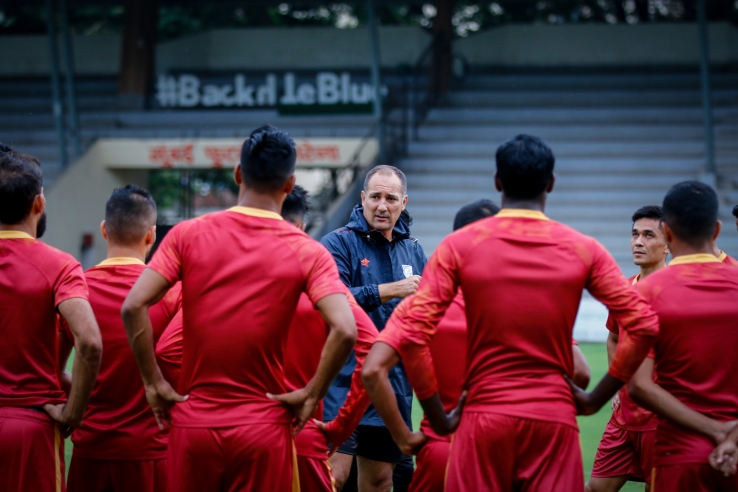India’s disheartening loss to Oman reeks of more erred tactics than individual errors
It was déjà vu all over again for the Indian football side on Thursday in Guwahati, where the Blue Tigers saw their tremendous hard work being undone by Oman’s late heroics to win their first FIFA WC qualifiers match. However, closer studies show, players could only be blamed so much for it.

Anyone remotely following English Premier League managers speaking in the post-match press conferences would have surely come across the phrase “striking the perfect balance” repeatedly. It is because, as vague as it sounds when the gaffer refers to it in the context of a game’s turning point, maintaining the equilibrium is the single most important task for the coach.
However, as far as India’s match against Oman was concerned, Igor Stimac didn’t quite manage to achieve it in the second half on Thursday. With the likes of Narender Gahlot and Sahal Abdul Samad missing from the first eleven, India’s starting eleven was already lob-sided. The midfield trio of Rowlin Borges, Anirudh Thapa, and Brandon Fernandes lacked physicality, and winger Asqhiue Kuruniyan was often seen dropping into the middle of the park.
Things still kept clicking for the Blue Tigers because Oman had realized very early on in the game that the 5’11, well-built Kurniyan couldn’t be stopped by man-marking alone, when the winger was seen bullying Harib Al-Saadi and Saad Al-Mukhaini in the 15th minute inside the box to keep the ball in play after Udanta Singh hit the crossbar.
Not known for their physical supremacy across the continent, Oman rely more on silky passing and making run behind opponents’ defences. Hence, tackling a relentless strong player on their right-wing meant they needed to commit their right-back as well as the right midfield, thereby throwing their pre-established out of the window.
There’s a good reason for that. Kuruniyan has been out and injured from the national team since Igor Stimac took charge of the side, making his last international outing back in January in the AFC Asian Cup. Hence, if Erwin Koeman did his homework by analyzing Stimac’s strategy from just the Intercontinental Cup and King’s Cup, it would have difficult to dominate proceedings from the beginning.
The amount of workload Kuruniyan was taking from minute one was unparalleled and after one of his lung-bursting runs in the 23rd minute saw Abdulaziz Al-Ghailani being forced into a rash tackle, and consequently getting booked, Oman were seen unwilling to take any risk making the first half an all-Indian affair.
However, things were about to change soon and the drastic defensive lapse that saw India conceding two goals in a span of ten minutes wasn’t a sudden occurrence. Stimac had set the ball rolling early in the second half when Lallianzuala Chhangte replaced Brandon Fernandes. Though Brandon, who came up with an assist for the India goal, in the playmaker’s role hardly made any difference up top, the team’s balance wasn’t upsetting because of it. But, when Chhangte came to the no.10 position, which was clearly not his favourable position, the balance was disturbed.
While the idea was to defend deep and counter Oman with pace, with the likes of Kuruniyan, Udanta, and Chhetri waiting up top, the execution was flawed. Running up and down on the left flank eventually saw Kuruniyan slowing down, which wouldn’t have been the case had he shifted to the No.10 role and Chhangte swapping places with him.
Oman, who had already come out in the second half with more intent, saw their task getting easier as Kuruniyan’s threat was slashed to half. All these small details were building up for the last ten minutes of the match, which eventually decided the outcome of the match. Stimac brought off the energy sapped Kuruniyan by introducing Manvir Singh, who was the second and perhaps the biggest blunder of the game.
For all of Manvir’s talent, he has always lacked creativity. And with Kuruniyan gone, Chhangte should have finally been pushed to the left wing, something which he was already doing unintentionally, whenever he had the ball. It was here that Sahal Abdul Samad could have been absolutely crucial with his ability to bring out the ball from congested places, for another goal in the final quarter would have killed the game for Oman.
Instead, Indian players were left to defend the last twenty minutes with whatever they had left in them after pressing relentlessly for seventy minutes. Oman, who were kept quiet for so long, always had the quality to inflict suffering and they did exactly as their backline were allowed to move higher up.
While one would agree that Rahul Bheke and Gurpreet Singh Sandhu could have done much more for the two goals that India conceded to lose the match, Stimac would need to show more strategic nuance if he is to make any sort of history with the bunch of talented players at his disposal.

Comments
Sign up or log in to your account to leave comments and reactions
0 Comments